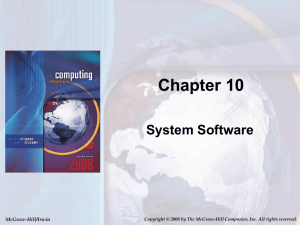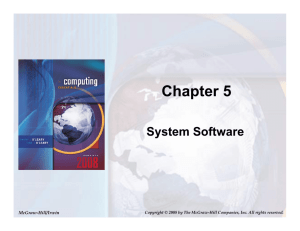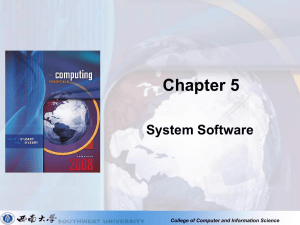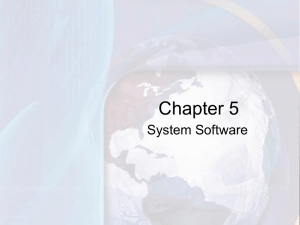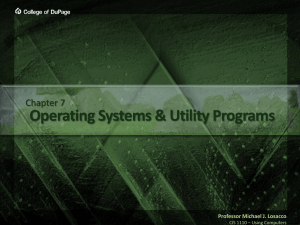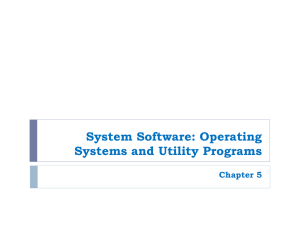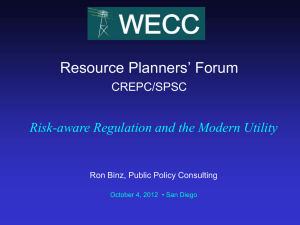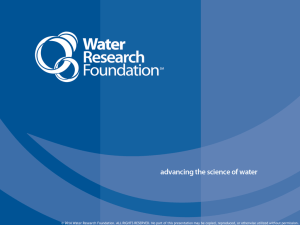Chapter 5 ppt下载
advertisement
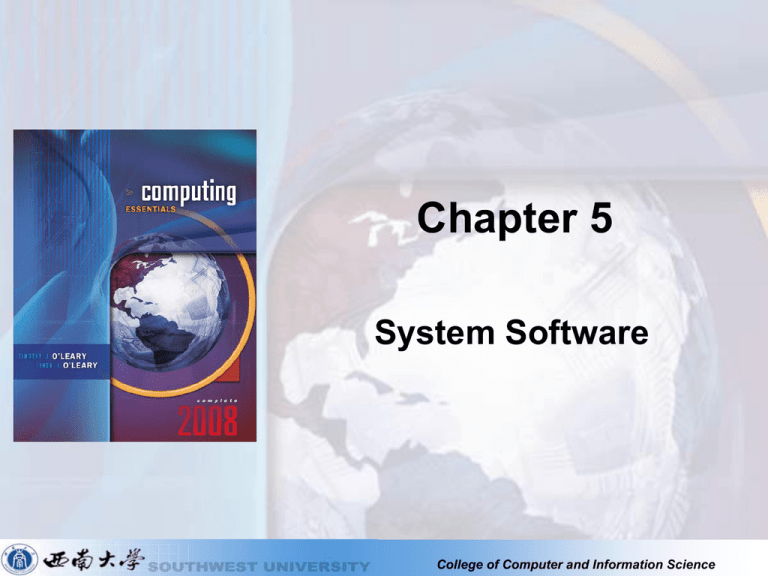
Chapter 5 System Software College of Computer and Information Science Key Words & Terms • • • • • • • • • • • • • • • • • Add Printer Wizard: 打印机添加程序 antivirus utility :防病毒工具 backup:备份 backup program:备份软件 Boot Camp:BC 软件(使苹果机可使用Windows系统) booting:启动 cold boot:冷启动 computer support specialist:计算机系统维护专家 Dashboard Widgets:苹果机软件包 desktop:台式机 desktop operating system :桌面操作系统 device driver:设备驱动程序 diagnostic utility:诊断工具 dialog box:对话框 Disk cleanup:磁盘清理 Disk defragmenter:磁盘碎片整理工具 embedded operating system:嵌入式操作系统 College of Computer and Information Science 5-2 Key Words & Terms • • • • • • • • • • • • • • • • • • file:文件 file compression program:文件压缩工具 folder:文件夹 fragmented:碎化 graphical user interface (GUI):图形用户界面 Help:帮助 icon:图标 language translator:翻译程序 Leopard:苹果机软件 Linux Mac OS Mac OS X menu:菜单 multitasking:多任务 network operating system (NOS) : 网络操作系统 network server:网络服务器 One Button Checkup:一种系统工具软件 operating system:操作系统 College of Computer and Information Science 5-3 Key Words & Terms • • • • • • • • • • • • • • • • • • • • platform:平台 pointer:指针 sectors:扇区 software environment:软件环境 Spotlight:苹果机软件 stand-alone operating system:个人操作系统 system software:系统软件 tracks:磁道 troubleshooting program:故障诊断软件 uninstall utility:卸载工具 UNIX:一种网络操作系统 user interface:用户界面 utility:工具软件 utility suite:工具软件包 virus:病毒 warm boot: 热启动 window: 窗口 Windows Windows Add Printer Wizard: Windows打印机添加程序 Windows Update: Windows升级程序 College of Computer and Information Science 5-4 Competencies (Page 1 of 2) • Describe the differences between system software and application software • Discuss the four types of system software • Discuss the basic functions, features, and categories of operating systems • Describe the Windows, Mac OS, UNIX, & Linux operating systems Page 126 College of Computer and Information Science 5-5 Competencies (Page 2 of 2) • Describe the purpose of utilities and utility suites • Identify the five most essential utilities • Discuss Windows utility programs • Describe device drivers, including printer drivers Page 126 College of Computer and Information Science 5-6 Introduction Computers and computer applications are ubiquitous in our lives so much so that we expect them to “be there when we need them”. We often give little thought to the processes and programs running behind the scenes to keep our computers functioning effectively. These kinds of programs and processes (i.e. operating systems, utility programs, device drivers, etc…) fall under the topic of system software and are covered in this chapter. Page 127 College of Computer and Information Science 5-7 System Software • Handles technical details • Works with end users, application software, and computer hardware • Four types of programs – Operating system – Utilities – Device drivers – Language translators Page 128 College of Computer and Information Science 5-8 Operating Systems • Manage computer resources • Provide an interface between the users and computer • Runs applications • A collection of programs that handle technical tasks • Every computer has an operating system Page 129 College of Computer and Information Science 5-9 Functions of an Operating System • Performs three types of functions – Manages computer resources • • • • Coordinate memory, processing storage, and printers Monitor system performance Provide security Start-up the computer – Provides user interface • Character-based interface • Graphical user interface (GUI) – Runs applications • Multitasking • Foreground & background applications Page 129 College of Computer and Information Science 5-10 Features of an Operating System • Booting • Features in common with application software – – – – – – Page 129 Icons Pointers Windows Menus Dialog boxes Help College of Computer and Information Science 5-11 Categories of Operating Systems • Hundreds of operating systems • Three basic categories – Embedded operating systems – hand-held – Network operating systems – linked computers – Stand-alone operating systems – desktop Page 130 College of Computer and Information Science 5-12 More on Operating Systems • OS often called software environment or platform • Operating systems commonly used by individuals – – – – Page 131 Windows – most widely used Mac OS – powerful and easy to use UNIX – network; originally designed for Web LINUX – non proprietary; free from the Web College of Computer and Information Science 5-13 Windows • The most popular microcomputer operating system – over 90 percent of the market • Comes in a variety of different versions • Windows XP is the most widely used version • Windows Vista was released in late 2006 Return Page 131 College of Computer and Information Science 5-14 Mac OS • An operating system designed to run on Apple computers • Not used as widely as Windows • One of the most innovative operating systems • Mac OS X is the latest version • The next version of Mac OS, Leopard, to be introduced in early 2007 Return Page 133 College of Computer and Information Science 5-15 UNIX and LINUX • UNIX operating system – Originally designed to run on minicomputers on a network – Used by powerful microcomputers • LINUX is a version of UNIX – Not proprietary – Open source Page 133 College of Computer and Information Science 5-16 Utilities • Specialized programs to make computing easier • Most essential utilities – – – – – Page 134 Troubleshooting or diagnostic programs Antivirus programs Uninstall programs Backup programs File compression programs College of Computer and Information Science 5-17 Windows Utilities • Backup • Disk Cleanup • Disk Defragmenter Accessing Windows XP utilities: Click Start, Select All Programs, Select Accessories, Choose System Tools Page 134 College of Computer and Information Science 5-18 Backup • Utility program included with many Windows versions • Makes a copy of all files or selected files that have been saved on a disk • Helps prevent against disk failure Return Page 135 College of Computer and Information Science 5-19 Disk Cleanup • Identifies and eliminates nonessential files • Frees up valuable space and improves system performance Return Page 136 College of Computer and Information Science 5-20 Disk Defragmenter • Identifies and eliminates unnecessary fragments • Rearranges files and unused disk space to optimize operations • Speeds up file access Page 137 College of Computer and Information Science 5-21 Utility Suites • A group of several utility programs bundled for sale • Buying the package is economical • Popular suites – Norton System Works – McAfee Office – V Communications SystemSuite Page 137 College of Computer and Information Science 5-22 Device Drivers • Specialized programs that allow communication between a device and the computer • Loaded into memory each time a computer is started • When a new device is added, new device drivers must be installed Page 139 College of Computer and Information Science 5-23 Virus Protection and Internet Security • Internet Security Suite – Runs a number of programs – Continually monitors your computer • VirusScan – Controls the frequency of searches for viruses – Quarantines or deletes infected files • PrivacyService – Helps protect your privacy online Page 140 College of Computer and Information Science 5-24 Discussion Questions (Page 1 of 2) • Describe system software. What are the four types of system programs? • What are the basic functions of every operating system? What are the three basic operating system categories? • Explain the differences and similarities between Windows, Mac OS, and Linux. Page 150 College of Computer and Information Science 5-25 Discussion Questions (Page 2 of 2) • Discuss utilities. What are the five most essential utilities? What is a utility suite? • Explain the role of device drivers. Discuss the Add Printer Wizard and Windows Update. Page 150 College of Computer and Information Science 5-26 The End of Chapter 5 College of Computer and Information Science 5-27
